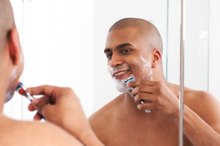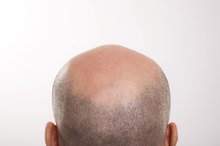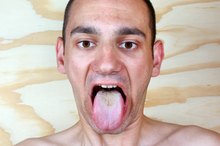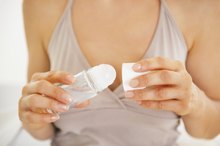Symptoms of an Infected Ingrown Hair
When you shave, it is usually to appear more put together or attractive. But shaving can cause ingrown hairs, leading to embarrassment and discomfort.
If you are experiencing serious medical symptoms, seek emergency treatment immediately.
Ingrown hairs occur when a hair gets stuck within the skin pouch holding each hair -- called a follicle -- rather than growing outward. They are often caused by cutting the hair very close to the skin, as when shaving. Ingrown hairs are more common in people with curly hair because their hair is more likely to curl back into the follicle 34.
Bacteria that normally reside on the skin's surface may collect in the follicle, producing an infected ingrown hair. Warmth, redness, itchiness, pain, a bump and pus are all possible symptoms of an infected ingrown hair.
Warm and Red
An infected ingrown hair causes inflammation, with warmth and redness. The "flame" in inflammation is a good way to remember that inflammation produces these symptoms. Warmth and redness are located around the infected follicle and may extend over a relatively large area if several follicles are irritated or infected. A larger area is especially likely to occur in regions where ingrown hairs are caused by shaving, such as the face, legs and genital area.
- An infected ingrown hair causes inflammation, with warmth and redness.
- Warmth and redness are located around the infected follicle and may extend over a relatively large area if several follicles are irritated or infected.
Itchiness and Pain
Home Treatment for Vaginal Ingrown Hairs
Learn More
Itchiness may appear before, during or after the warmth and redness of an infected ingrown hair. It may be especially apparent in areas where clothing causes friction, such as the genitals and upper thighs. Infected ingrown hairs can also be painful, especially when touched.
- Itchiness may appear before, during or after the warmth and redness of an infected ingrown hair.
- Infected ingrown hairs can also be painful, especially when touched.
Bump and Pus
Ingrown hairs often produce a bump that can be seen or felt. Because of this, they are frequently mistaken for simple pimples. Close inspection, however, often reveals a hair curled within the bump. When an infection sets in, the follicle becomes more swollen, producing a more obvious bump.
The follicles of infected ingrown hairs may also fill with pus as white blood cells in the body accumulate to fight off the invading bacteria. When this occurs, the follicles look like pus-fllled blisters 34.
- Ingrown hairs often produce a bump that can be seen or felt.
- When this occurs, the follicles look like pus-fllled blisters.
How to Remove Ingrown Arm Hair
Learn More
If you have an ingrown hair, avoid picking at the area. This can cause an infection to develop or make an existing infection worse. Keeping your skin moisturized and wearing loose clothing may help reduce the symptoms of an infected ingrown hair and allow your body to clear the infection on its own. When washing the area, use a clean cloth, water and an antibacterial soap.
If you have an infected ingrown hair, an over-the-counter antibiotic cream -- such as a cream containing bacitracin -- may be useful. Do not shave the area until all symptoms are gone. When you resume shaving, move the razor in the direction of hair growth and use a sharp, single-bladed razor to reduce the likelihood of another ingrown hair.
See your doctor if your infected ingrown hair does not significantly improve in a few days or if it is getting worse 34. Seek prompt medical care if you develop a fever or notice that the redness and warmth is spreading beyond the initial area. Your doctor may remove the hair with sterile tools and prescribe antibiotics -- usually a cream applied to the skin but sometimes pills as well 34.
Reviewed by Mary D. Daley, M.D.
- If you have an ingrown hair, avoid picking at the area.
- Keeping your skin moisturized and wearing loose clothing may help reduce the symptoms of an infected ingrown hair and allow your body to clear the infection on its own.
Related Articles
References
- Massachusetts General Hospital: Ingrown Hairs
- Best Practices BMJ Group: Folliculitis
- WebMD: Folliculitis
- Mayo Clinic: Folliculitis
- MedlinePlus. Acne.
- Cleveland Clinic. Ingrown hair. Updated February 28, 2018.
- Merck Manuals. Ingrown beard hairs. Updated October 2019.
- Cleveland Clinic. Ingrown hair: Management and treatment. Updated February 28, 2018.
- Ogunbiyi A. Pseudofolliculitis barbae; current treatment options. Clin Cosmet Investig Dermatol. 2019;12:241-247. doi:10.2147/CCID.S149250
- MedlinePlus. Folliculitis. Updated October 8, 2018.
- Zaenglein AL, Pathy AL, Schlosser BJ, Alikhan A, Baldwin HE, et. al. Guidelines of care for the management of acne vulgaris. Journal of the American Academy of Dermatology. 2016; 74(5): 945-73. doi:10.1016/j.jaad.2015.12.037
Writer Bio
Dr. Dawn Runge holds a Doctor of Chiropractic and master's degree in nutrition. She has written more than 60 articles for a weekly health and fitness column owned by AOL News. She has also competed in fitness competitions, and enjoys dancing and reading. She resides in Orlando, Fla.








